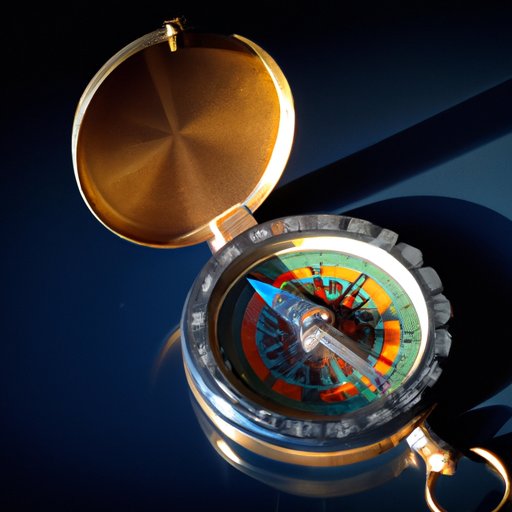
I. Introduction
If you enjoy outdoor activities like hiking, orienteering, or camping, knowing how to read a compass is an essential skill. A compass can help you navigate through unfamiliar terrain, keep you on course when the weather gets bad, and even save your life in an emergency situation. In this article, we will provide you with a step-by-step guide on how to read a compass, including defining basic terminology, orienting a map, and using more advanced techniques like sighting and taking bearings.
II. Step-by-Step Guide
Before we dive into the specific steps of using a compass, it’s essential to define some basic terminology. The four cardinal directions are North, South, East, and West. Magnetic North represents the direction that a compass needle points towards the magnetic north pole. True North is the direction towards the geographic North Pole. To identify North using a compass, you need to align the compass needle with Magnetic North. Once you have identified North, it’s time to orient your map using a compass.
When you are orienting your map using a compass, you need to place the compass on your map and align it with the grid lines. Then, you need to rotate the map and the compass together until the compass needle points towards Magnetic North. Once the compass needle is pointing towards North, your map is properly oriented.
Advanced techniques like sighting and taking bearings require more precision and accuracy. To take a bearing, you need to align the compass with a landmark or point on the map, then determine the angle between the landmark and North. This angle represents the bearing, or the direction you need to travel.
III. Real-World Application
The practical uses for a compass are virtually endless. Hiking, camping, and orienteering are all activities that require navigation skills. If you’re lost in the wilderness, a compass can be a lifesaver. Additionally, compasses are often used in search and rescue operations and by emergency responders. Even if you’re not an outdoor enthusiast, there are plenty of scenarios in which a compass can be helpful, such as finding your way around an unfamiliar city or navigating through an airport.
When using a compass in different scenarios and environments, there are some essential tips you should keep in mind. In the wilderness, always carry a paper map and a compass, and make sure to check the declination before you set out. When navigating through an urban environment, it’s crucial to take note of landmarks like buildings, street signs, and public transportation stops.
IV. Historical Perspective
The history of compasses dates back to ancient China, where they were used for divination purposes. However, they weren’t used for navigation until the 11th century. The invention of the compass was a turning point in maritime history, allowing sailors to navigate more accurately and explore new lands. Christopher Columbus, for example, used a compass on his journey to discover America.
Compasses have played a critical role in shaping world history. During the Age of Exploration, navigators used compasses to cross oceans, discover new lands, and establish trade routes. In the military, compasses were used to plan strategies and coordinate troop movements. Today, compasses are still an essential navigation tool and an important part of our cultural heritage.
V. Advanced Techniques
When you’ve mastered the basics of using a compass, there are more advanced techniques you can explore. For example, you can use a compass to triangulate your position, which involves taking bearings to three or more surrounding landmarks. By drawing lines on a map that intersect at your location, you can pinpoint your exact position.
You can also determine magnetic variation, which is the difference between Magnetic North and True North. Depending on your location and the declination, this variation can significantly affect your navigation accuracy. To determine magnetic variation, you need to consult a chart or a map that illustrates the declination values for your region.
If you’re an experienced user looking to refine your skills, there are several tips you can follow. For example, you can practice taking bearings in different terrain types, such as hills, forests, and valleys. You can also challenge yourself by navigating through unfamiliar terrain without a map or compass, using only natural or man-made landmarks.
VI. Visual Aids
Visual aids can be a helpful way to understand how to use a compass. Many online resources offer diagrams, infographics, and videos that illustrate the steps outlined in this article. These visual aids can help you see how to align your compass with the map, how to take bearings, and how to determine magnetic variation.
VII. Conclusion
Knowing how to read a compass is a valuable skill that can benefit you in countless ways. Whether you’re an outdoor enthusiast, a traveler, or an emergency responder, a compass can help you navigate through unfamiliar terrain or find your way out of a tricky situation. By following these step-by-step instructions, practicing your skills, and exploring more advanced techniques, you can become a master at using a compass.





